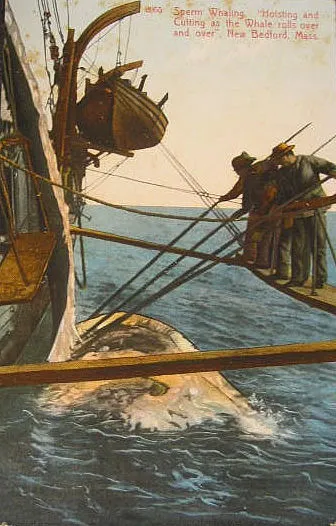Outboard flensing
Whales and Whaling pictures
Next
Previous
Back to gallery
Back to whale and whaling
thumbnails

In the days of wooden sailing ships, there was not the means available to bring a dead whale on board to be processed or "flensed". So the flensing took place by the side of the ship. This was known as "outboard flensing". A wooden platform, the "cutting stage" was suspended about midships, men would walk out onto this precarious structure and begin to cut the whale up with flensing knives - razor sharp blades maybe 1-2ft long on the ends of 10ft+ handles.
Holes were cut in the whales skin at various points an large wooden toggles inserted. These would be connected to ropes that via blocks and winches, or simply a lot of men on the other end, would begin to strip the whale of its blubber. Pieces of blubber and other whale parts would then be hauled aboard to be further cut up and processed.
The great advantage to this method was that the whale could easily be rolled over by use of the ropes and winches. The disadvantages were the precarious position of the flensers, the difficulty of wielding such long knives and perhaps most of all that the whale and ship would not move in unison making flensing all but impossible if the sea started to get rough at all. There was also the added excitement that the flensing might attract sharks that would launch themselves at the whale carcass and bite of great chunks of meat or blubber while the flensers went about their work.
Picture from an old postcard (who'd send a postcard like this?)
